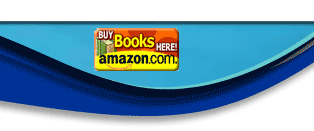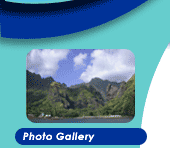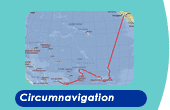Our First Visit to the Catana Factory
July 19, 2000 |
This morning we awakened early in our comfortable little room at Hotel de la Loge in Perpignan Centre, already charged with anticipation. Our appointment with the Catana factory in Canet was not until 11:00 AM but our eyes were wide open, our heads spinning… “Let’s find a nice little café at the market plaza,” I suggested, “perhaps something substantial, with eggs, to hold us over, since we most likely will be having lunch late.” We dressed quickly in our white slacks and lightweight tops, prepared for summery weather at the beach town of Canet, and left for the plaza. At 7:30 AM, the bustling marketsquare of yesterday was still asleep, doors rolled up and stalls closed, but we did manage to find a few cafes open on the canal leading to the Castille. We went from one to another looking for eggs. as Gunter became impatient, desperate for his morning coffee fix. Unfortunately, breakfast in France is not called “petite déjeuner” for nothing! Coffee with croissants, or baguettes, butter and jam is breakfast here. “Eggs are usually delivered at noon”; one proprietor told us. Apparently, they are not used in any dish, such as an omelet, “omelette,” before then. We were able to purchase a ham sandwich (a baguette with butter and ham) which sufficed for today. We found our way to Canet easily, and once there, directions to Zone technique du port were clearly marked. As one enters the Zone, Catana signs at each turn provide directions to the factory.
As we entered the factory, we found the reception area sleek and modern,
carrying out the Catana colors and theme to the finest detail, red knobs
and trim on the white doors contrasting with the blue handrails on the
stairway leading to the second floor.
Photo: The top of a Cat under
construction in the Catana shipyard. I recalled the admonitions of cruising “self-help” books and articles: “you will be called by the name of your boat, not by your own name, so take that into consideration when you select a name.” This was the first time we’d been called Pacific Bliss. I liked the sound of it. If we are called the Bliss’s it is OK by me. “I suppose you’d like to see your yacht, first,” Christophe said, speaking English easily. Taking our grins for an answer, he led us to the bays where the yachts are built. We walked on a gangway above the huge factory floor. Each yacht had the model number and the assigned number posted at the bay; e.g. Pacific Bliss was 431-22, the 22nd Cat in the 431 (43-foot) series. The 431’s are interspersed with the larger 471’s.
Photo: Pacific Bliss bulkheads and interior.
Photo: The Monster Cat.
In addition to specifying the finishing of the underbed storage for the three cabins, we added a seawater pump in the galley, and finalized the design for the navigation station’s instrument panel. We had previously shipped the electronics from the U.S. Interfacing these electronic components to work well was a key reason for our visit. After Gunter and Christophe made a rough sketch of the equipment interface, the assignment was given to a software engineer, who completed the layout on his CAD system while we watched. We approved the design this afternoon. We also made small modifications, such as switching the location of weather fax output with the battery indicator on the electrical panel for easier viewing (without glasses), and changing the location of the fan in the master cabin. We found that the curve of the hardtop that replaces the bimini in an earlier design does not allow for the larger solar panels that we had requested, but by adding four more regular-sized panels, we doubled our capacity for solar electrical generation. All in all, we found the Catana employees helpful and courteous. The factory was clean and orderly and the workflow appears to be well organized. We had visited at the right time in the manufacturing process, and were relieved to learn that Pacific Bliss remains on schedule. We left the factory--happy that we had built this visit into our plan and convinced that the visit had been necessary. We look forward to a smooth commissioning and sea trial process in October. We do not expect that it will be 100% problem-free, but we do not anticipate any major problems or changes. Back at Hotel de la Loge, we flopped on our bed exhausted, napped for
an hour or so until the music began, drifting invitingly through our
window from the narrow cobblestone streets of the City Centre. As the
sun set, we changed clothes and retreated to our favorite restaurant,
Le Catalan, in the courtyard of Le Castillet, and relaxed,
enjoying the band, excellent seafood tapas and a smooth red wine. |
journal3.html |
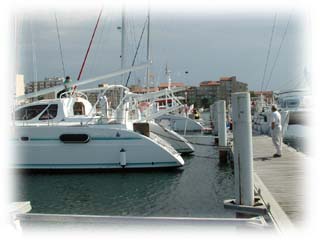 Since
we were early, we parked and walked around the Catana shipyard. The
stark white factory building immediately impressed me, with the red,
white, and blue Catana logo clearly displayed, and the cleanliness of
the yard. Then we walked onto the dock—about 200 feet or so from
the factory building. Wow! To see new and used Catana Cats all lined
up at the pier—431’s, 471’s and an older 401—was
a feast for the eyes. After all the correspondence, phone calls, and
contract negotiations, we were finally here—going forward with
our dream! Photo: The Catana Dock
Since
we were early, we parked and walked around the Catana shipyard. The
stark white factory building immediately impressed me, with the red,
white, and blue Catana logo clearly displayed, and the cleanliness of
the yard. Then we walked onto the dock—about 200 feet or so from
the factory building. Wow! To see new and used Catana Cats all lined
up at the pier—431’s, 471’s and an older 401—was
a feast for the eyes. After all the correspondence, phone calls, and
contract negotiations, we were finally here—going forward with
our dream! Photo: The Catana Dock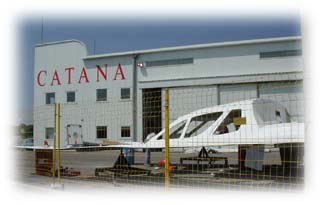
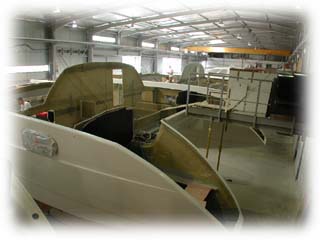 We
were led from the gangway onto a platform leading down on to Pacific
Bliss. The hull and first deck is completed, with the bulkheads
in place. The workers had finished the engine compartments and
storage lockers and were busy stringing the cables. The top will
be added last, after the interior is completed.
We
were led from the gangway onto a platform leading down on to Pacific
Bliss. The hull and first deck is completed, with the bulkheads
in place. The workers had finished the engine compartments and
storage lockers and were busy stringing the cables. The top will
be added last, after the interior is completed.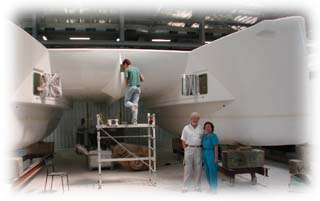 After
examining the interior of Pacific Bliss, we were led to the factory
floor, where we were awestruck at the sheer size of the hulls. Since
the bulk of the hulls are underwater when a Cat is at sea, we did not
have a feeling—until now—for the immensity, in terms of volume,
of our new floating home.
After
examining the interior of Pacific Bliss, we were led to the factory
floor, where we were awestruck at the sheer size of the hulls. Since
the bulk of the hulls are underwater when a Cat is at sea, we did not
have a feeling—until now—for the immensity, in terms of volume,
of our new floating home.



